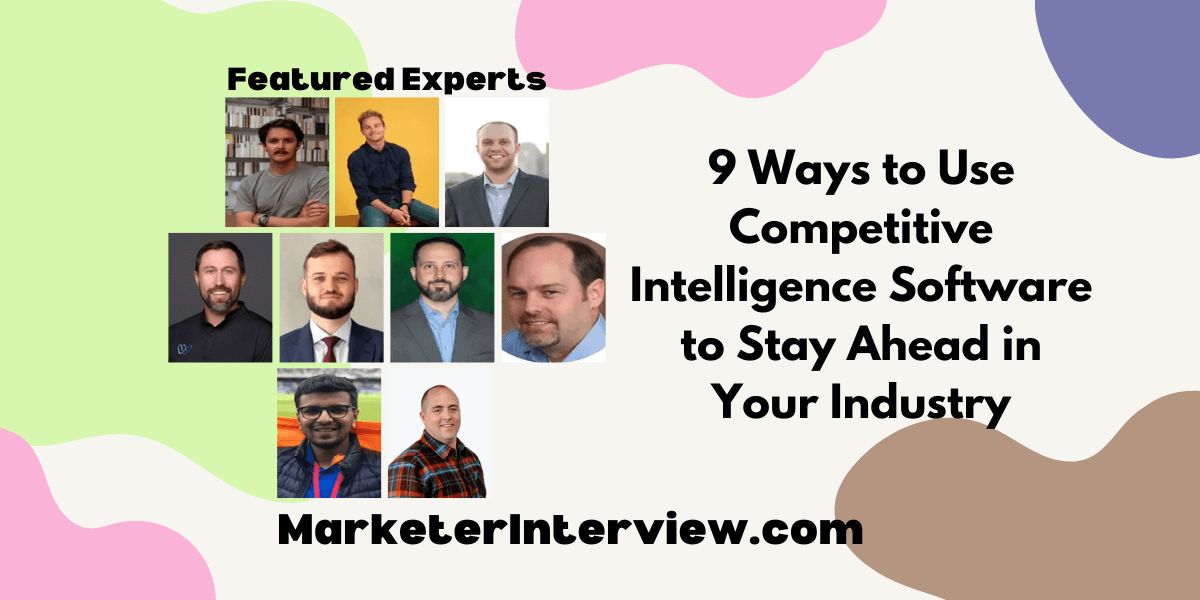9 Ways to Use Competitive Intelligence Software to Stay Ahead in Your Industry
In the fast-paced world of business, staying ahead means leveraging every tool at your disposal, including competitive intelligence software. We’ve gathered insights from CEOs and Co-Founders on the specific ways they use this technology to maintain an edge. From assessing AI adoption trends to tracking competitors’ marketing strategies, explore the nine distinct tactics these industry leaders employ.
Want to get quoted in MarketerInterview.com content just like this? Apply to become a contributor today!
Contents
- 1 Assess AI Adoption Trends
- 2 Analyze Competitors’ Content Strategies
- 3 Visualize Data for Stakeholder Insights
- 4 Monitor Competitors’ Pricing Strategies
- 5 Track Competitor Website and Digital Updates
- 6 Observe Competitor Job Listings and Reviews
- 7 Monitor Customer Feedback on Competitors
- 8 Identify Market Demands with CI Software
- 9 Track Competitors’ Marketing Strategies
Assess AI Adoption Trends
At AI Insider Tips, I use competitive-intelligence software to assess AI adoption rates in different industries. I track which companies are starting to use AI and what they’re using it for. This helps me spot new trends and opportunities for our clients. I also look at how successful these AI projects are and what problems companies face. By analyzing this information, we can give better advice about how to use AI in business.

Ryan Doser, Co-Founder, AI Insider Tips
Analyze Competitors’ Content Strategies
We use competitive intelligence software to stay ahead in our industry by closely monitoring the content strategies of other companies. By analyzing competitors’ websites, we gain insights into the types of content they produce, allowing us to tailor our own content strategy to better meet the needs and interests of our audience. This helps us identify trending topics, successful formats, and gaps in the market that we can fill.
Moreover, we don’t limit our analysis to just within our industry. We also examine content from companies outside the software development industry, as these often offer fresher and more innovative approaches. For example, industries like fashion, sports, influencer content, and broader tech often produce highly engaging and user-centric content. By incorporating these insights, we can elevate our content quality and creativity, setting us apart from typical industry standards. This broader perspective allows us to create more compelling and diverse content that resonates with a wider audience, ultimately giving us a competitive edge.

Visualize Data for Stakeholder Insights
I’m using competitive intelligence tools to relay insights to key stakeholders, which helps me properly report and visualize relevant data. This data is crucial for developing processes and optimizing business operations, allowing me to stay ahead of the competition. The first part of my process is identifying themes in my research. The second part is presenting these insights to key stakeholders.
They can then use this information to drive business growth and increase revenue.
One important thing I keep in mind is that as a data analyst, I’m the storyteller. I’m tasked with analyzing the data and also framing it in a way that explains why it’s important. Without this critical element, it can be tough to see the next steps.
I also make sure to tailor my reports to the needs of my team. For example, our sales team might find battle cards most useful, while our marketing team might prefer a breakdown in visual form. If I’m not sure what would work best, I find that the best approach is to go directly to the source. I collaborate with my teams to figure out the most effective way to communicate our findings.

Alex LaDouceur, Co-Founder, Webineering
Monitor Competitors’ Pricing Strategies
We utilize competitive intelligence software to track and analyze our competitors’ pricing strategies. This enables us to dynamically adjust our pricing to stay competitive without sacrificing profitability. By monitoring market trends and competitors’ pricing changes in real-time, we can make informed pricing decisions and swiftly adapt to market fluctuations. This proactive approach has allowed us to maintain a competitive edge in our industry and respond effectively to pricing pressures, ultimately driving customer acquisition and retention.

Gregory Shein, CEO, CORCAVA
Track Competitor Website and Digital Updates
Leveraging competitive intelligence software, I focus on tracking competitor website changes and digital footprints. This software alerts me to updates in their service offerings, pricing strategies, and content updates. Analyzing these movements helps me anticipate market trends and adjust our strategies proactively, ensuring we always offer something more innovative or cost-effective. This approach has kept us steps ahead in the competitive tech landscape, driving growth and maintaining our edge.

David Wilfong, Founder and CEO, DavidWilfong
Observe Competitor Job Listings and Reviews
One way I leverage competitive intelligence is by watching our competitors’ job listings and employee reviews on sites like Glassdoor. By analyzing the required qualifications and skills for various roles, I gain insight into where competitors are investing and potential new services they may be developing.
For example, when I noticed several data-science job postings from a major competitor, it signaled to me that they were likely expanding into AI and looking to gain a competitive edge with predictive analytics. My team reacted quickly and partnered with an AI startup to offer customized machine-learning solutions for our clients ahead of our competitor’s new launch.
We’ve also used employee reviews to improve our own company culture and retention. Seeing what competitors’ own staff identify as weaknesses or areas for improvement in their work environments helps ensure we avoid the same pitfalls. Reviews praising strong mentorship programs, for instance, prompted us to invest more heavily in leadership training and career development plans for our team.
Leveraging these kinds of insights into our competitors’ priorities, challenges, and next moves has been integral to staying one step ahead in a competitive industry. We aim to gain any advantages we can to best serve our clients, and competitive intelligence platforms provide a key source of data to help us do just that.

Victor Santoro, Founder & CEO, Profit Leap
Monitor Customer Feedback on Competitors
As the founder of Leverage, staying ahead of the game is super important to me. One way we do this is by using a tool called Crayon to keep an eye on what customers are saying about our competitors.
Crayon tracks online reviews, social media mentions, and other feedback about other companies in our industry. This helps us see what people like and don’t like about their experiences.
For example, we noticed that a lot of customers were frustrated with how complicated some insurance policies were. They mentioned confusing terms and a hard-to-navigate application process. Seeing this, we decided to simplify our policies and make our application process much easier.
We redesigned our insurance products to be more straightforward and created clear, easy-to-follow guides and tutorials. This not only made our current clients happier but also attracted new ones who were fed up with our competitors.
We also monitor social media to see what’s trending in the world of insurance and finance. This helps us tweak our marketing strategies quickly to stay relevant and address current concerns.
Using Crayon has really paid off. Our customer satisfaction has improved, and we’ve seen an influx of new clients. It shows that we listen and care about our clients’ needs, which is key to our growth and success at Leverage.

Rhett Stubbendeck, CEO & Co-Founder, Leverage Planning
Identify Market Demands with CI Software
At Suspire, we utilize competitive intelligence software to monitor trends and analyze competitor strategies in the sustainable products sector. This tool enables us to stay agile and responsive to market shifts. For instance, by leveraging this software, we identified a growing demand for plastic-free packaging solutions among eco-conscious consumers. We promptly adjusted our product offerings, introducing a new line of plastic-free packaging options. As a result, we achieved a 43% increase in sales within the first year of launching these new products. This proactive approach not only helps us anticipate market needs but also reinforces our position as a leader in sustainable alternatives. Our use of competitive intelligence software empowers us to innovate and meet customer demands effectively, driving our continued growth in the competitive sustainability landscape.

Swayam Doshi, Founder, Suspire
Track Competitors’ Marketing Strategies
Competitive intelligence software helps you stay ahead by tracking competitors’ marketing strategies. Regularly analyze their ad campaigns, keyword usage, and social media engagement. This insight reveals trends and gaps in the market, allowing for strategic adjustments. For example, noticing a competitor’s success with a specific keyword led to refining our own SEO strategy, boosting organic traffic and maintaining a competitive edge.

Trevor Bailey, Co-Founder, Taxfluence
Want to get quoted in MarketerInterview.com content just like this? Apply to become a contributor today!






